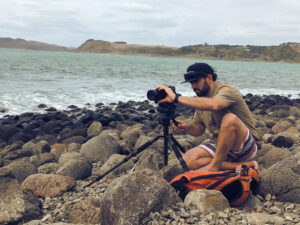“How do Indigenous Peoples relate to and regard introduced species?” asks Dr. Reo, Dartmouth professor and citizen of the Sault Ste. Marie Tribe of Chippewa Indians. Reo approaches his work with a mindset that goes beyond narrow ecological questions, and rather focuses on building relationships with local knowledge holders. NYISRI is pleased to highlight his work for this month’s researcher spotlight:

What kinds of research questions related to invasive species are you currently asking?
Indigenous Peoples around the world tend to regard plants and animals in their home territories as integral parts of their networks of family relations- plants, animals, and other entities such as water and stones are understood to be part of Indigenous genealogies and are kin. I am interested in understanding how introduced species fit into Indigenous Peoples’ networks of more-than-human kin. How do Indigenous Peoples relate to and regard introduced species? What gifts, if any, do these species offer to humans in new locations, and reciprocally what responsibilities do humans have toward these new residents?
What are the basic methods you are using to answer your research questions?
I work closely with local knowledge holders and try to take a relational approach to my work. In this context, “relational” means that I’m not trying to extract information from local “informants” but rather I stand with local knowledge holders and try to contribute in some way to their priority initiatives. The work I do with Indigenous practitioners is deeply personal, so it is important to move beyond basic professional relationships in my collaborations. When my work is going well, members of our teams become close friends and in some cases become close enough to consider each other family. I am interested in building longterm, loving relationships with my collaborators. In my experience, working in this way results in more generous and more generative partnerships that result in deeper relationships and deeper insights.
Do you have a personal story or path that led to your interest in this research?
I started the research phase of my career with a vision of using applied ecology to address questions important to Anishnaabek tribal nations, but found that the types of questions my tribal partners and I were most interested in addressing required interdisciplinary, Indigenous methodologies. The discipline of ecology is reputed for being the most holistic of the sciences, but it’s narrow compared to Indigenous sciences. The Western scientific discipline of ecology favors narrow questions and isolating variables so that mechanistic functions can be understood more “clearly.” But when I narrow my questions down to basic mechanisms, the work feels esoteric and loses relevancy to community partners and I don’t particularly dig that. Even the broader pursuits within ecology, like the study of complex systems, are not a good fit for me. In this branch of ecology, groups of researchers with specific expertises collaborate, each focused on a particular cog so they can try to understand the full machine. Mother Earth is not a machine or a “system.”
How does your research relate to the wider field of invasive species prevention/management?
My work relates to other aspects of invasive species prevention/management because I am working directly with Indigenous environmental guardians who interact with invasive species daily. I also aim to inspire conservation practitioners and policy makers to think more broadly and to think beyond the confines of Western sciences and Euro-centric worldviews.
What’s the most important thing about your research for managers and policy makers to know?
It’s important to have a basic understanding of Indigenous politics and perspectives.
What do you hope the long-term impact of your work will be?
I envision a future where Indigenous Peoples have the space politically, ontologically, and physically to thrive and to determine their own paths. I hope to contribute in some small way to the realization of this vision.

